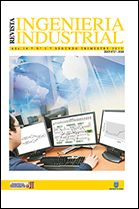Percepción del riesgo músculo-esquelético en tareas de almacenamiento en estibas
Palabras clave:
Demanda Biomecánica, Riesgo Músculo Esquelético, Análisis Factorial, Ergonomía, Tareas, Estibas, Demand Biomechanics, Musculoskeletal Risk, Factor analysis, Ergonomics, Tasks, Pallets.Resumen
Con el objeto de medir el nivel de riesgo músculo esquelético a tareas de armado de pedidos en estibas o paletas desde la perspectiva de los trabajadores, se diseña un estudio de tipo exploratorio de corte transversal que utiliza como herramienta de captura de información, un
instrumento basado en las variables críticas de este tipo de actividades. Dicha estrategia logró identificar la valoración que tienen los trabajadores de la demanda biomecánica y por ende el nivel de afectación músculo esquelética que produce la ejecución de las tareas asociadas a
su cargo. La información fue procesada con análisis factorial y se identificaron siete factores que explican el 65,6% de la varianza total. Los resultados son discutidos a partir de diversas investigaciones previas en puestos de trabajo similares y las conclusiones más importantes
destacan a la dimensión Compromiso Biomecánico por volumen de pedidos como la de mayor nocividad referida. El estudio de los valores reportados apunta a la necesidad de formación permanente de los individuos de tal forma que se garantice el conocimiento pleno
de las tareas que ejecutan y los riesgos que éstas implican.
In order to measure the level of risk of skeletal muscle work of assembling orders in pallets from the perspective of workers, an exploratory study was conducted. An instrument is designed based on the critical variables of this type of activities that allowed workers from 1
to 5 assess the level of involvement that causes skeletal muscle performance of tasks. The information was processed with factor analysis and identified seven factors explaining 65,6%
of the total variance. The results are discussed from the perspective of risk levels reported by research that show the impact of such situations on musculoskeletal health and the most important findings highlight the dimension biomechanical load of volume of orders as the most
harmful referred. The study of the reported values points to the need for continuous training of individuals so that the full knowledge of the tasks performed and the risks they entail is guaranteed.
Descargas
Citas
AGHILINEJAD, Mashaallah et al. Work-Related Musculoskeletal Complaints Among Workers of Iranian Aluminum Industries. Arch Environ Occup Health, 2012, vol. 67, no. 2, p. 98-102.
BERNARD, Bruce. A critical review of epidemiologic evidence for work-related musculoskeletal disorders of the neck, upper extremity and low back. Centers for disease control and prevention (NIOSH). NIOSH publication. 1997, p. 97-141.
CIRIELLO, Vincent. The effects of container size, frequency and extended horizontal reach on maximum acceptable weights of lifting for female industrial workers. Applied Ergonomics, 2007, vol. 38, no. 1, p.1-5.
FEWSTER, Kayla., and GRENIER, Sylvain. Emotion affects torso force production during flexion and extension movements: implications for spine loading. Theoretical Issues in Ergonomics Science, 2012, vol. 13, no. 6, p. 615-624.
FLORIDO DÍAZ, Francisco. Riesgos biomecánicos asociados al manipulado de frutas y hortalizas. En: Actas del VIII Congreso Internacional de Prevención de Riesgos Laborales. Valencia 5-7 de mayo del 2010,2010. ID 1592.
GARCÍA, Carlos., and RODRÍGUEZ, Eliana. Evaluación ergonómica en una empresa del sector alimenticio venezolano. Revista Ingeniería Industrial Bío-Bío, 2010,no. 1, p. 95-108.
HIGNETT, Sue., and MCATAMNEY, Lynn. Rapid Entire Body Assessment (REBA). Applied Ergonomics, 2000, vol. 31, p.201-205.
JOHNSON, Dallas. Métodos multivariados aplicados al análisis de datos. México: International Thomson Editores, 2000, 566 p. ISBN: 9687529903.
KHAN, Abid., O’SULLIVAN, Leonard., and GALLWEY, Timothy. Effects of combined wrist flexion/extension and forearm rotation and two levels of relative force on discomfort. Ergonomics, 2009, vol. 52, no. 10, p. 1265-1275.
LAVENDER, Steven et al. Developing Physical Exposure-Based Back Injury Risk Models Applicable to Manual Handling Jobs in Distribution Centers. J Occup Environ Hyg., 2012, vol. 9, no. 7, p. 450-459.
LEE, Jungyong., and NUSSBAUM, Maury. Experienced workers exhibit distinct torso kinematics/kinetics and patterns of task dependency during repetitive lifts and lowers. Ergonomics, 2012, vol. 55, no. 12, p. 1535-1547.
LEVY, Jean-Pierre., and VARELA, Jesús. Análisis multivariable para las Ciencias Sociales. Madrid: Pearson Prentice Hall, 2003, 862 p. ISBN: 9788420537276.
NATIONAL INSTITUTE FOR OCCUPATIONAL SAFETY AND HEALTH.Publicación de NIOSH No. 2010-106: Transporte, almacenamiento y servicios públicos, Octubre de 2009.[ref. de 28 de julio de 2010]. Disponible en http://www.cdc.gov/spanish/niosh/docs/2010-106_sp/
PRAT, Remei., and DOVAL, Eduardo. Construcción y análisis estadístico de escalas. En: LÉVY, Jean-Pierre; VARELA, Jesús. (eds.).Análisis multivariable para las ciencias sociales. Madrid: Pearson Educación, 2003. p. 44-89.
PLAMONDON, André et al. Relative importance of expertise, lifting height and weight lifted on posture and lumbar external loading during a transfer task in manual material handling. Ergonomics, 2011, vol. 55, no. 1, p. 87-102.
RODRÍGUEZ, Eliana. Ergonomía en una empresa distribuidora de bebidas: Estudio integral. Revista Ingeniería y Sociedad, 2009, vol. 4, no. 2, p. 83-90.
SEO, Na Jin., ARMSTRONG, Thomas., and YOUNG, Justin. Effects of handle orientation, gloves, handle friction and elbow posture on maximum horizontal pull and push forces. Ergonomics, 2010, vol. 53, no. 1, p. 92-101.
SNOOK, Stover., and CIRIELLO, Vincent. The design of manual handling tasks: revised tables of maximum acceptable weights and forces. Ergonomics, 1991, vol. 34, no. 9, p. 1197-1213.
VICENTE Y OLIVA, María., and MANERA, Jaime. El análisis factorial y por componentes principales. En: LÉVY, Jean-Pierre; VARELA, Jesús. (eds.), Análisis multivariable para las ciencias sociales. Madrid: Pearson Educación, 2003. p. 327-360.
WATERS, Thomas., PUTZ-ANDERSON, Vern., and GARG, Arun. Application manual for the revised NIOSH lifting equation. Cincinnati: Department Health and Human Services, 1994, p. 94-110.
Descargas
Publicado
Número
Sección
Licencia
Revista Ingeniería Industrial by Revista Ingeniería Industrial is licensed under a Creative Commons Reconocimiento 4.0 Internacional License. Creado a partir de la obra en revistas.ubiobio.cl/index.php/RI/. Puede hallar permisos más allá de los concedidos con esta licencia en http://revistas.ubiobio.cl/index.php/RI/about/

















